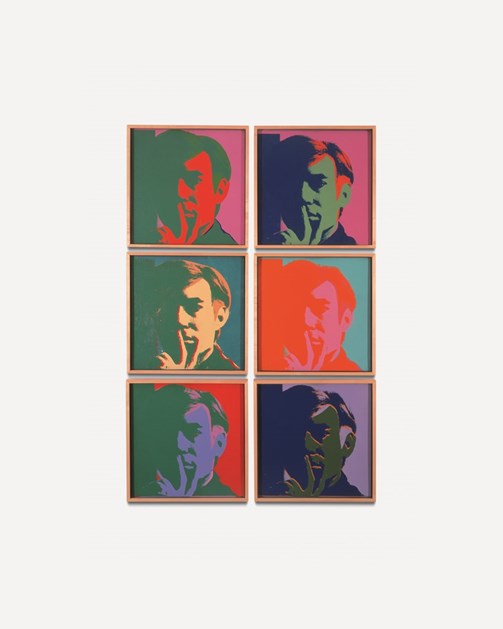WHEN Andy Warhol released Silver Clouds from the roof of his Factory studio in New York, in 1965, he looked up to the heavens, as if making a votive offering, saying: “It is infinite, because it goes to the sky.” A room full of Silver Clouds is the first encounter at Ireland’s largest ever Warhol exhibition at Hugh Lane. Plump pillows of silver bump your nose and brush against legs like curious cats, in a playful, joyous immersion in the lighter side of the artist’s career.
Drawings from the 1950s, after Warhol had left his Byzantine Catholic family home in Pittsburgh to become a successful commercial artist in New York, cover a wall of the next gallery. Among the male nudes, male torsos holding guns, and dollar bills with the artist’s face in the centre is Clasped Hands with Rosary (1957), outlining two forearms, one bare and one with a loose cuff, suggesting a vestment, hands joined with interleaved fingers. A cross is suspended below the left knuckles, with rosary beads looping around the thumb, and the opposite wrist. Everything is delicate and minimal, the broken oval of the beads echoing the larger ovals of the neat nails.
An ink-on-paper drawing from the same period gives an androgynous figure in light, broken line, an enormous halo and heavily feathered, neck to calf wings, like a mythical creature. The halo and wings heavy line contrasts with the ethereal detailing of the figure, stretching possibilities for the angelic image.
Warhol’s silk-screens of Campbell’s soup, Marilyn Monroe, and Mao are motifs of the 20th century, and “Three Times Out” presents these familiar images afresh. The close-up portraits of Marilyn Monroe, taken from a cropped publicity still for Niagara (1953), are hung near repetitions of Mao, self-portraits of Warhol, and the square-format series Flowers, begun in 1964 and based on a magazine image of hibiscus blossoms.
Warhol went on to create more than 450 paintings in colour registers from brash and loud to luminous and fluorescent, declaring that “Repetition adds up to reputation.” The image for the Mao series (1972) was taken from a portrait in the little red book, The Thoughts of Chairman Mao, which Warhol considered to be comparable to the image of a god, and the only likeness of their leader which many of China’s citizens would have seen. By rendering the leader’s face in green, ochre, burgundy, grey, blue, and other colours, often colouring his lips to match the shade of his utilitarian tunic with unstiffened collar wings and large buttons, Warhol uses the intense artificial colours to play with the established authority of the portrait. He renders a ubiquitous image unnerving.
 © 2023 The Andy Warhol Foundation for the Visual Arts, Inc. / Licensed by Artists Rights Society (ARS), New York.Andy Warhol, Self-Portrait (1966), silk-screened synthetic polymer paint and enamel, pencil, and ballpoint pen on six canvas panels, from the Eli and Edythe L. Broad Collection
© 2023 The Andy Warhol Foundation for the Visual Arts, Inc. / Licensed by Artists Rights Society (ARS), New York.Andy Warhol, Self-Portrait (1966), silk-screened synthetic polymer paint and enamel, pencil, and ballpoint pen on six canvas panels, from the Eli and Edythe L. Broad Collection
Pre-dating Mao by five years, the Marilyns were the first technically complex set of prints that the artist made. The discordant colour register from neon bright to darker hues saturates Monroe’s celebrated features with foreboding and sadness. Based on the 1963 press coverage of the assassination of President Kennedy, the Jackie series has the same pietà mood. Losing his own father when he was 15, and feeling unable to participate in the open-coffin wake held in his family living room, Warhol was fascinated by images of the grieving First Lady, dressed in black, face obscured by a mantilla, for deep-rooted reasons. Barbara Dawson, director of Hugh Lane, describes this collection of works as “the jewels of pop art”.
Pop art conjures up images of bright colours and comic-book jollity, but Warhol’s darker side reigns in a series of rooms with the feeling of a catacomb, Images of the Electric Chair (1971) at Sing Sing, used to execute Julius and Ethel Rosenberg, parents of a young family, on questionable charges of spying, are rendered in screenprints of shocking pink, baby blue, acid yellow, and a plane divided vertically between orange and washed-out sepia.
The serial layout highlights the chasm between the viewer and the depicted event, encouraging critical examination of complicity in the consumption of such images, and the power and control exerted by the state. Is the electric chair a symbol of societal disarray, an apparatus of punishment and torture, or an image that charges the viewer’s gaze? Parallels between the iconic presentation of the electric chair and crucifixion images are hard to ignore.
Examples of the memento mori continue with the Skull series from 1976, based on a human skull bought in a Paris flea market the year before. The vivacious colours of red, yellow, blue, and purple are at odds with the sombre message of the dual still-life and universal portrait.
“Warhol recognised the power of television before everybody else,” Ms Dawson says. The interviews in Fifteen Minutes are prophetic of MTV and the jump-cut, tickertape captions of youth TV, 20 years ahead of its time. In the Portrait Films made between 1964 and 1968, the camera eerily holds the gaze of its subject, whether that is Salvador Dalí or a crying woman, in horror-film-style lighting, challenging the viewer not to turn away. Sleep (1964), the five hours of footage of his lover John Giorno asleep, can be read as another meditation on life’s fragility.
“
Three Times Out” reveals Warhol’s incredible hinterland beneath the lid of celebrity and soup.
“Andy Warhol: Three Times Out” is at Hugh Lane Gallery, Charlemont House, Parnell Square North, Dublin, until 28 January. Phone 00 353 1 222 5564. hughlane.ie